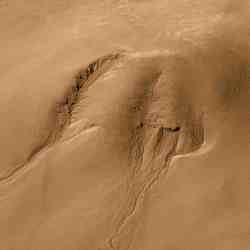Mars gullies in Noachis Terra region. Image credit: NASA
Click to enlarge
It was only a few years that researchers announced the discovery of gullies on Mars. Here on Earth, gullies like this are formed when water flows quickly down a hill, and erodes the soil. Unfortunately, there might be another explanation for the Martian version - since similar gullies have now been seen on the Moon as well. It's possible that the gullies are formed completely dry, when micrometeorites strike the side of a crater wall and trigger a landslide.
If you're a scientist studying the surface of Mars, few discoveries could be more exciting than seeing recent gullies apparently formed by running water.
And that's what scientists believed they saw in Mars Orbital Camera (MOC) images five years ago. They published a paper in Science on MOC images that show small, geologically young ravines. They concluded that the gullies are evidence that liquid water flowed on Mars' surface sometime within the last million years.
A word of caution, though: The moon has gullies that look like that, a University of Arizona Lunar and Planetary Laboratory researcher has found. And water certainly didn't form gullies on the waterless moon.
Gwendolyn D. Bart is presenting the work today at the 37th Lunar and Planetary Science Conference in Houston.
"We'd all like to find liquid water on Mars," Bart said. "That would be really, really exciting. If there were liquid water on Mars, humans wouldn't have to ship water from Earth when they go to explore the planet. That would be an enormous cost savings. And liquid water near the surface of Mars would greatly increase the chances for native life on Mars."
The 2000 Science paper was provocative, Bart said. "But I was skeptical. I wondered if there is another explanation for the gullies."
Then last year she heard a talk by Allan Treiman of the Lunar and Planetary Institute. Treiman suggested the martian gullies might be dry landslides, perhaps formed by wind and not formed by water at all.
Recently, Bart was studying the lunar landscape in high-resolution images taken in 1969, prior to the Apollo landings, for her research on processes that modify the lunar surface.
"Totally by accident, I saw gullies that looked strikingly like the gullies on Mars," she said.
"If the dry landslide hypothesis for the formation of martian gullies is correct, we might expect to see similar features on the moon, where there is no water," she said. "We do."
Gullies in the moon's 10-mile-diameter (17 kilometer) crater Dawes are similar in structure and size to those in a martian crater that MOC photographed. Micrometeorites hitting the smooth slopes and crater on the airless moon could easily trigger small avalanches that form gullies, Bart said.
However, the martian gullies also resemble gullies on Earth that were formed by water, she noted.
"My point is that you can't just look at the Mars gullies and assume they were formed by water. It may be, or may be not. We need another test to know."
UA News Release
 Universe Today
Universe Today
